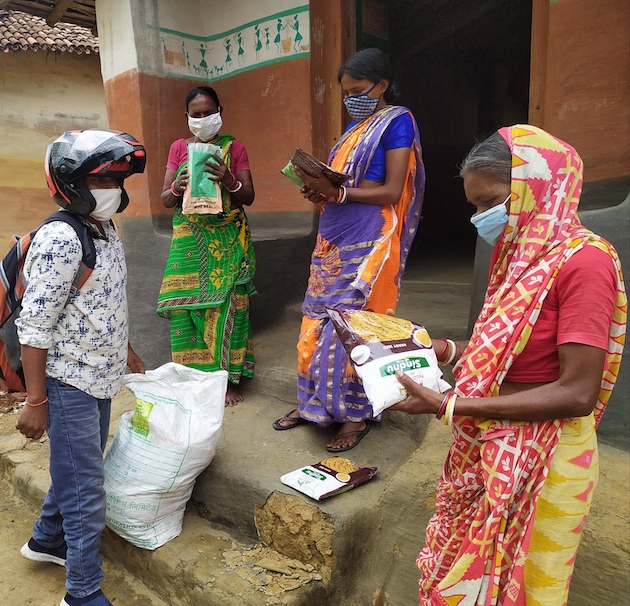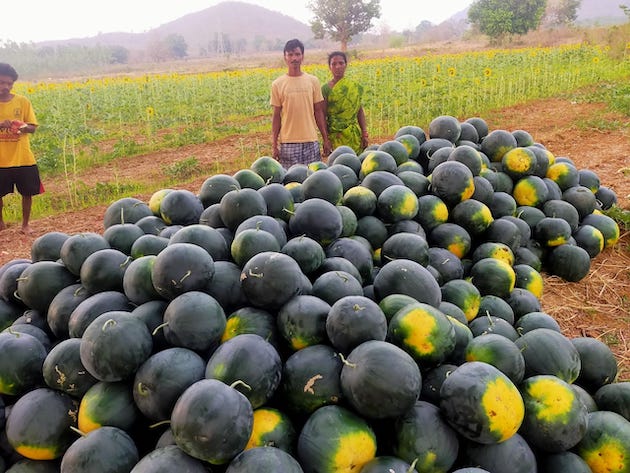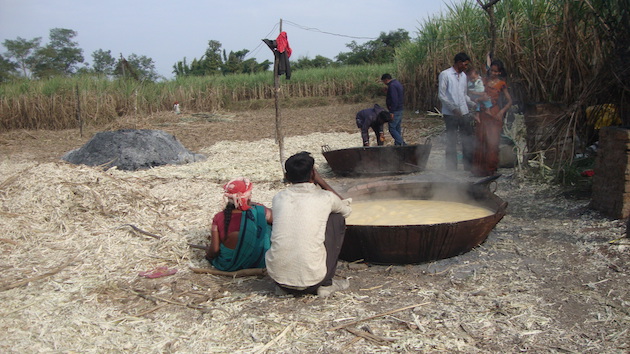How Farmer Producer Organisations Benefit Small Scale Farmers in India — Global Issues
MANDLA, JHARGRAM & AHMEDNAGAR, INDIA, May 26 (IPS) – Until a decade ago, marginal farmers Gangotri Chandrol and Sunitabai lacked livelihood options in the post-monsoon season.
With farm holdings of just 2-6 acres in Katangatola village in the tribal-majority Mandla district of Madhya Pradesh, they could only grow wheat, paddy, and sugarcane in the wet season for a living.
“Our earnings depended on price fluctuations in the market and the little paddy and wheat procured by the government.”
But now, they can sell their produce at higher than the prevailing market price to their farmers’ collective set up by Ekgaon Technologies, using existing women’s microfinance self-help groups (SHGs).
Furthermore, value-added products like flavoured jaggery obtained from sugarcane ensure a good income. Farmers like Gangotri and Sunitabai, who were organised into clusters, and trained to form collective bargaining as buyers of agricultural inputs and suppliers of produce, are better off as a result.
While agriculture is India’s primary employment source, agricultural productivity has remained low. This is because the average size of an agricultural plot is less than 2 hectares (4.942 acres) (as per 2001 figures), with a quarter of rural holdings as low as 0.4 hectares (0.988 acres).
Furthermore, poverty and illiteracy make it difficult for most farmers to apply modern scientific inputs to enhance yield. Climate change has further added to the problem, with erratic weather, unseasonal rains, and frequent storms taking their toll on standing crops.
Realising this, India’s National Bank for Agriculture and Rural Development (NABARD) developed its Producer Organisation Promoting Institution (POPI) scheme in 2015. This saw several Farmer Producer Organisations (FPOs) flourish around 2015, and farmers were inducted into registered companies, holding a certain number of shares, each priced at a nominal sum.

Ekgaon and its mission in Mandla
Once a single crop with migration-prone villages, Mandla district has seen a facelift ever since Ekgaon Technologies brought together its rural women and organised them into a Farmer Producers Organisation (FPO). Encouraged to buy seeds and fertilizer to distribute within their organisation, the women emerged as small-time entrepreneurs.
Traditionally, paddy cultivators, the farmers here, were trained to move to multi-cropping using natural organic farming methods. Local farmers now grow a mix of paddy, wheat, lentils (Masur), pigeon pea (arhar/tur), green gram (mung), and sugarcane on their marginal farms, using improved techniques and inexpensive homemade organic fertilizers.
Vidhi Patel, a widow and marginal farmer with a one-acre farm, tells IPS, “We were using 40 kg of seeds on our one-acre farm to grow paddy, besides spending on urea, which cost us upwards of Rs 1000. Under the System of Rice Intensification (SRI) method, we now use only 25 kg of seeds, which has halved costs.”
Gangotri Chandrol, Sunitabai Chandrol, and Devki Uikey have not just learned to make optimum use of their marginal 2-6 acre farms to grow a variety of traditional crops such as wheat, paddy, sugarcane pigeon pea, masur (lentils), mung (green legumes), and millets, but have now ventured into cash crops like arrowroot, flaxseed, nigerseed, and marigold, which fetch them good returns.
Similarly, Laxmibai and Devki Uikey of the neighbouring Khari village grow sugarcane on one acre of their 3-acre farm and paddy, wheat, marigold and beetroot on the rest. Besides operating as a small-time entrepreneur, selling agricultural inputs to other members of her FPO, Devki Uikey made organic yellow and maroon colours for the Holi (spring) festival out of beetroot and marigold with some other members of her collective.
“We procured 25 kg of marigold at Rs 40 per 250 g and 10 kg of beetroot at Rs 160 per kg. After making and selling the colours, we earned Rs 2300-Rs 2500 per member,” Devki Uikey told IPS
Besides selling premium varieties of rice such as Chindi Kapur and Jeera Shankar that are native to Mandla but not available elsewhere, Ekgaon has developed value-added products such as millet-ginger-raisin nutribars, millet noodles, amla ( gooseberry) candy, which it markets alongside ( collected) forest products like medicinal herbs, beeswax, and honey, on its e-commerce platform.
Since sugarcane is a major crop in the district and jaggery-making is an important enterprise, Ekgaon has developed ginger and tulsi (basil) flavoured jaggery cubes to brew flavoured tea. Being part of the FPO has other benefits too. Farmers can access government funds for rainwater harvesters and borewells easily.
A tie-up with Rajdhani Besan, which markets gram flour, helped farmers who cultivate gram, while a tie-up with Lays saw the entire produce of white peas bought over in bulk for (Lays) chips and wafers. The FPO is also grading and procuring wheat for the government, earning the women farmers a small sum.
Consequently, marginal farmers who earned around Rs 50,000 (USD 608) per acre in the past are easily making Rs 3,00,000 (USD 3647) per acre now. Migration has stopped in most villages, and the literacy level has improved.
PRADAN’s initiatives in Jhargram and Bankura
Professional Assistance for Development Action (PRADAN) has also converted existing women’s microfinance self-help groups (SHGs) into FPOs in the resource-poor, tribal-majority Bankura and Jhargram districts of West Bengal.
Despite good monsoon rains, water scarcity is the norm in these paddy-growing districts, owing to rocky terrain. Of late, erratic rains have made matters worse, spurring out migration. To withstand the vagaries of the weather, the women farmer-shareholders of the Amon Mahila Chashi Producers Company Limited (Amon Women Farmers Producers Company Limited) and other FPOs now grow hardy, traditional paddy varieties using homemade organic fertilizers.
Sumita Mahato, whose family lives off a one-bigha (0.625 acres) farm, and Swarnaprabha Mahato, whose three-bigha (1.875 acres) farm must provide for an eight-member family, told IPS: “Chemical fertilizers cost Rs 5000 per 0.625 acres, while homemade organic fertilizer costs us only Rs 80-90 for the same per bigha.”
It has helped them get organic certification for their produce, comprising traditional rice varieties like Malliphul, Satthiya (red rice), and Kalabhat (black rice), earning them Rs 35 per kg (as against Rs 12 per kg that rice grown with chemical inputs). Rainwater harvesters accessed as members of the FPO, under the state government’s scheme for the region, have helped, too, increasing productivity from 25-30 quintals per acre to 40-45 quintals per acre.
As multi-cropping is impossible here owing to limited moisture in the rocky soil, the farmers grow turmeric as a cash crop on the village commons. In Jhargram, Sonajhuri (Acacia auriculiformis) and Cashew are grown for timber and nuts, while in Bankura, farms along the Kankabati River grow watermelons for collective profit.
Traditionally, women in these regions made plates from sal (Shorea robusta) leaves collected from the jungles. They now process and mould plates for urban markets using moulding machines, selling them with their other products online on IndiaMart, earning ample profits to lead well-settled lives.

WOTR’s Efforts in Maharashtra
In Parner taluka (sub-division) of Ahmednagar district of Maharashtra, the community-led Ankur Farmer Producers Organisation (FPO), facilitated by the Watershed Trust (WOTR), comprises 762 farmer-shareholders from the villages of Hiwrekorda, Bhangadevadi, and Dawalpuri, with farm holdings of 3-15 acres range, who supplement their incomes through dairy farming.
Being a rain-shadow, the drought-prone region with limited water resources, farming was always rainfed here, with large tracts of land lying barren.
Once Ankur was formed, the farmers could avail of Rs 80 lakh from the State Government (of Maharashtra) contributing the rest to lay a 7.5 km pipeline to bring water from the Kalu river and fill up a lined farm pond, and set up a pump-house for collective benefit.
This enabled them to bring 100 acres of farmland under cultivation to grow onions, marigolds, chrysanthemums, and other crops for the market. Their rainfed single-crop lands also grow two crops with the additional moisture available.
The farmers have opted for organic inputs like vermicompost, which they prepare and sell, both within and outside their FPO, although, as farmers Somnath Palwe and Chandrakant Gawde say, “Our members use both organic and improved seeds, as per preference.”
From growing a single crop of bajra (pearl millet), jowar (sorghum), and pulses, the farmers now grow maize, green gram, marigold, chrysanthemum, and onions, besides cauliflower and tomato. Incomes have grown from as low as Rs 50,000 ( USD 61) for an acre of cultivable land to as high as Rs 5 00,000 (USD 731).
Ankur sells its products online to Ninjacart and offline-in wholesale markets. In both cases, the sale is direct and without middlemen. Farmer Ashok Phalke, tells me. “Onions used to fetch us Rs 10 per kg, while the market price was Rs 12 per kg. We would lose Rs 2 per kg. Now that we sell directly in markets as a group, we earn more. The same goes for tomatoes and flowers.”
Besides promoting organic farming, the FPOs stress natural multi-cropping methods to control pests, such as growing horse gram in combination with maize or sorghum. This attracts birds, which, in turn, help control harmful pests naturally. Kitchen gardens are encouraged as they counter nutritional deficiencies in farming families.
Government Encouragement of FPOs
The Indian government intends to set up 10,000 FPOs all over India for Rs 6865 crore. Under this scheme, FPOs are to receive financial assistance of up to Rs 18 lakh for three years, with each farmer-member being eligible for an equity grant and credit guarantee facility. However, not all existing FPOs have been co-opted into the government scheme.
Since millets are hardy and impervious to erratic weather patterns, the government has been pushing for their cultivation in regions where they were traditionally grown. But the government’s dictum of “one District, one Product” has invited criticism, especially from grassroots organisations, who see multi-cropping as the only guarantor against natural disasters such as hailstorms and cyclones.
IPS UN Bureau Report
Follow @IPSNewsUNBureau
Follow IPS News UN Bureau on Instagram
© Inter Press Service (2023) — All Rights ReservedOriginal source: Inter Press Service
Check out our Latest News and Follow us at Facebook
Original Source







